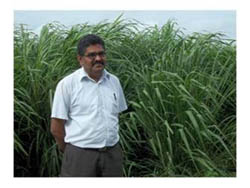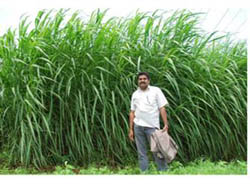 Srhi Shrishail Timmanagoudar, 39 a commerce graduate holds 11 acre farm on Pune-Bangalore highway at Hiremalligawada village of Dharwad district. In 2007, he decided to start dairy farm as an enterprise and consulted Dharwad regional research station of Indian Grassland and Fodder Research Institute of Jhansi for technical know-how on fodder cultivation. Scientists of the regional station visited his farm to take the stock of resources available in his farm, such as type of soil, irrigation source, land topography, labour availability and daily fodder requirement. Labour scarcity was the major constraint noticed as his farm is located mid-way between urban and industrial areas. Hence, fodder plan was prepared by incorporating only high yielding perennial fodder crops as labour requirement for these crops is less when compared with annual fodder crops.
Srhi Shrishail Timmanagoudar, 39 a commerce graduate holds 11 acre farm on Pune-Bangalore highway at Hiremalligawada village of Dharwad district. In 2007, he decided to start dairy farm as an enterprise and consulted Dharwad regional research station of Indian Grassland and Fodder Research Institute of Jhansi for technical know-how on fodder cultivation. Scientists of the regional station visited his farm to take the stock of resources available in his farm, such as type of soil, irrigation source, land topography, labour availability and daily fodder requirement. Labour scarcity was the major constraint noticed as his farm is located mid-way between urban and industrial areas. Hence, fodder plan was prepared by incorporating only high yielding perennial fodder crops as labour requirement for these crops is less when compared with annual fodder crops.
 High yielding Bajra Napier hybrids (IGFRI-7 and DHN-6) were recommended to plant with a spacing of 60 X 60 cm in fertile part of his land and Guinea grass was recommended for moderately fertile part. Planting material for these crops was purchased by the farmer from IGFRI-RRS, Dharwad. Planting of rooted slips was demonstrated to him in his farm by the scientists and also closely supervised planting activity as it is the most important step for maintaining persistence and good yield in perennial crops. As per the plan, initially he planted in only two acre land. He was guided about dose and timely fertilizer application and inter-cultivation aspects. Technical know-how on cutting management to ensure green fodder through out the year was given.
High yielding Bajra Napier hybrids (IGFRI-7 and DHN-6) were recommended to plant with a spacing of 60 X 60 cm in fertile part of his land and Guinea grass was recommended for moderately fertile part. Planting material for these crops was purchased by the farmer from IGFRI-RRS, Dharwad. Planting of rooted slips was demonstrated to him in his farm by the scientists and also closely supervised planting activity as it is the most important step for maintaining persistence and good yield in perennial crops. As per the plan, initially he planted in only two acre land. He was guided about dose and timely fertilizer application and inter-cultivation aspects. Technical know-how on cutting management to ensure green fodder through out the year was given.
First cutting was taken by him after 70 days of planting and scheduled the subsequent cuttings in such a way that every six line of fodder crop must come for harvest in 45-50 days. In the first year, on an average he obtained 2-2.5 q green fodder every day to feed his 27 high yielding animals. In Kharif 2008, earthing up of soil was suggested as it was noticed that the roots of these fodder crops were spreading on the ground. He was buying 30 tractor loads of dry fodder @ Rs.4500/ load made out of straws of various cereals and pulses to meet feed requirement of his animals every year which was adding to his cost. In 2010, convinced by the benefits of growing high yielding fodder crops and to reduce his expenditure on dry fodder, he expanded the area under these improved fodder crops to six acres. With this he is now able to harvest on an average 6 q green fodder daily. As a legume component, he was advised to take up Sesbania sesban along the field boundary. He started with 18 buffaloes and gradually increased herd size. He has constructed animal shed in around 4500 sq.ft area to accommodate 40 animals.
“I am now getting 120 ls of milk a day which is sold at the rate of Rs. 35/l” says Shrishail proudly. “My expenditure on feed concentrate has gone down considerably after I started feeding green fodder” tells Shrishail. He claims that 20-30% of extra milk yield is solely due to use of green fodder. “Due to availability of green fodder round the year I am planning to further increase my herd size” he adds.
(Source: IGFRI, Jhansi)







फेसबुक पर लाइक करें
यूट्यूब पर सदस्यता लें
X पर फॉलो करना X
इंस्टाग्राम पर लाइक करें